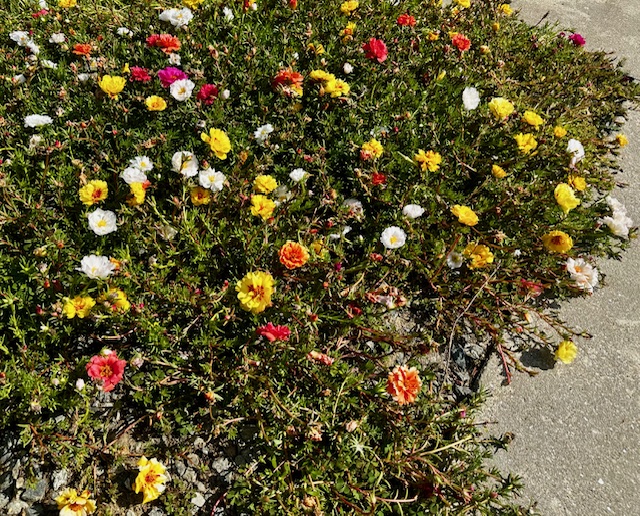Portulaca and Other Amazing Self-Seeding Plants
A year ago, I became fascinated by the self-seeding nature of annual Portulaca, or Moss Rose. My fun and talented cousin’s colorful Portulaca, in both containers and in-ground drifts, had created this fascination. This year, returning to the same site that got me so interested, I find myself once again focused on self-seeding annuals… plants I can purchase now, enjoy for a while, and let go to seed. Fingers crossed, the seeds will germinate and sprout next year.
This year, the Portulaca I mention here seems to be more colorful and healthier than ever. I saw it last September, and this year, just now… and it’s even more glorious now.
What gives? Portulaca is an annual in my zone… in Dennis’s horticultural zone, too. But Portulaca, in a good spot where it can sunbathe each day for six hours or more, plus reap the benefits of well-draining soil, is an annual that won’t give up on the gardener. If given the chance to develop seed pods and drop seeds into the soil, Portulaca can go from giving one year of pleasure to giving many. I’ve seen it. It’s true.
.jpg)
Annuals, as you know, complete their life cycle in one year. They’re not meant to return. But self-seeding annuals can perform in a manner than might make us mistake them for perennials. As long as you avoid disturbing them with a clean-up in autumn, these self-seeding wonders can find a way to ensure that new plants will sprout up around the areas where this year’s “annuals” sit on display. Case in point: My cousin’s vibrant and full Portulaca.
What are some other self-seeding annuals…? Cosmos and Columbine, if left alone, will self-seed. Asters self-seed, and I have new proof of that this year: A dusty lavender beauty has risen up in a part of my yard where I thought I had nothing. Violas self-seed, though in my garden, they’ve rarely been given the opportunity to have seed heads form. A missed opportunity, I am now thinking…. I will let them go to seed from here on out and see what happens. And my favorite self-seeder, in addition to Portulaca, is the perennial known as Sweet Autumn Clematis.
Sweet Autumn Clematis self-seeds aggressively, sometimes causing it to be called invasive. But I am the beneficiary of my neighbor’s Sweet Autumn Clematis vine… the beneficiary of seeds that blew in on the wind, into my garden. Call it an aggressive self-seeder. I call it beautiful. Sign me up! (I hope the wind patterns are the same this autumn, for I want more.)
So, talk of perennial Clematis aside: As you plant-shop around Labor Day and into fall, you’re likely to see deals on annuals, especially. You might think, “Well, isn’t that nice… but the season is almost over.” But realize that the season can turn into multiple seasons, as long as you let your self-seeding plants work their magic. While you might have an area or two that you are eager to tidy up, resist the urge. Let the plants go to seed, provided they are, in fact, self-seeders, and let the seeds determine where they want to drop and then come up. In the case of my cousin’s Portulaca plants, the new seedlings appear in roughly the same spots each year. The spread is not very wild or uncontrolled. Instead, the seeds drop to the ground, under the mother plants… no worries. They really would trick most of us into thinking they’re perennials.

I’m crossing my fingers in hopes that this wonderful relative of mine, prone to doing his own work, never hires a landscaper. A landscaper might do some overzealous yard work when the leaves fall and the weather turns. I hope he manages not to disturb the wonderful flower patches I just saw, and lets his container plantings sit in place. His self-seeding Portulaca plants are doing fine under this approach—better than fine, in fact, and better than most Portulacas I have seen. Leave it to Dennis. And leave it to a great self-seeding plant.
Comments
{{ errors.first("comment") }}